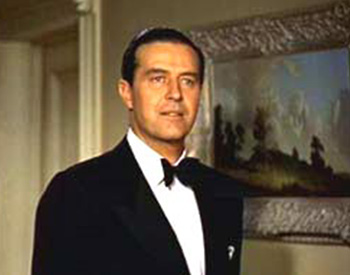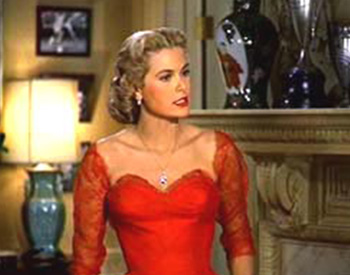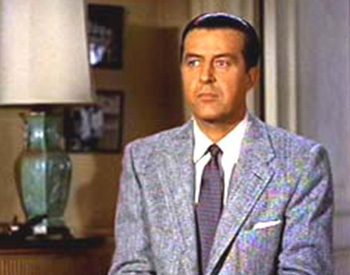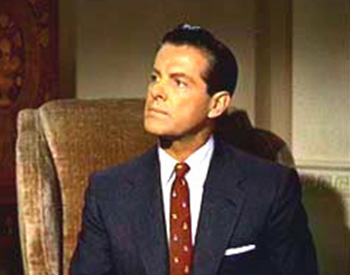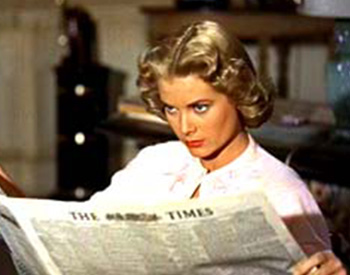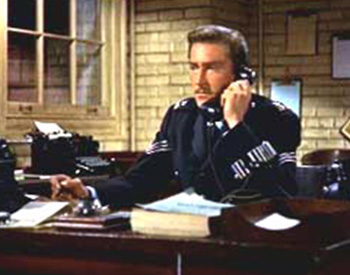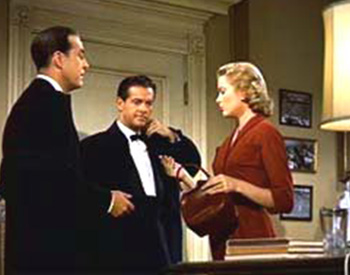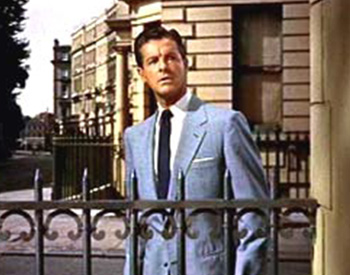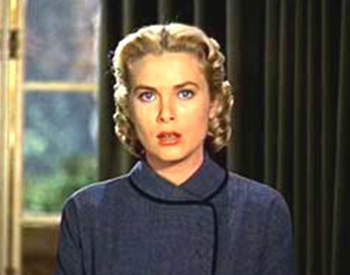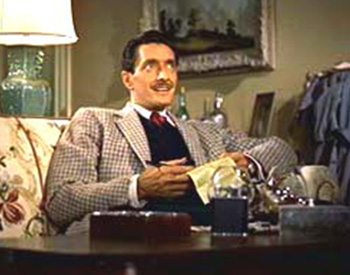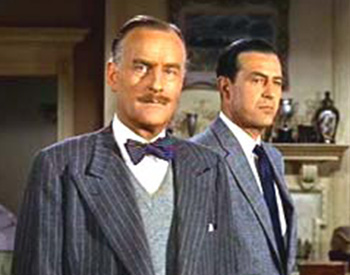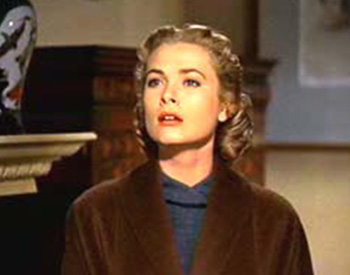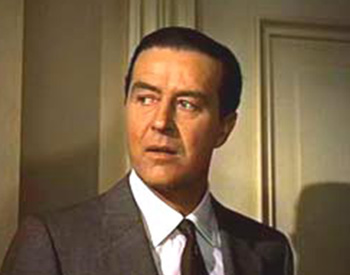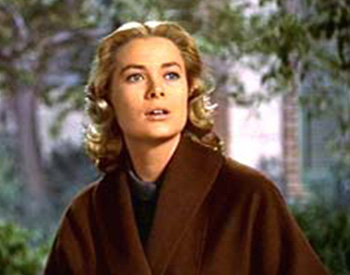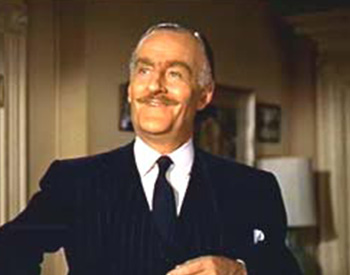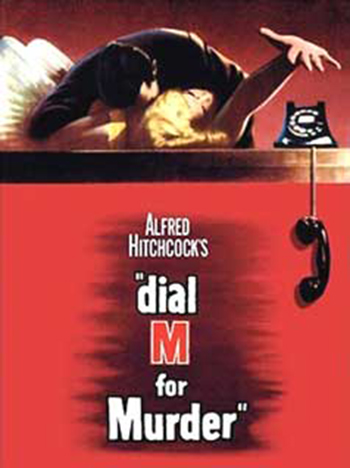
Directed by: Alfred Hitchcock
Screenplay by: Frederick Knott
Cast:
Tagline: “ The key to the key is which key is the right key?”
Rated:
DIAL M FOR MURDER is a classic Hitchcock film that consistently develops a psychological suspense throughout its entirety. The film follows the ill fated antagonist Tony Wendice and his malevolent attempts to murder his wife after he discovers her elicit long distance affair.
See the Dial M
for Murder trailer
The setting is contemporary England in the 1950's. A happy couple sits silently over a hearty morning breakfast. Margot Wendice (Grace Kelly) averts her attention to the morning paper while her husband Tony Wendice (Ray Milland) gazes indifferently through her aloof countenance. The film depicts the typical married couple of the 1950's; that is until Margot begins to search the papers for the arrival of renowned American author, Mark Halliday (Robert Cummings), and the introduction quickly smacks of deceit, betrayal, and bad times to come.
As Margot nonchalantly bids her husband good day with a gentle kiss, the scene pans to her intensely affectionate embrace with none other than Mark Halliday. As it goes, Margot and Mark have been conducting a long distance affair for over a year. Throughout the course of the affair there have been broken hearts and love letters of emotional protestation; all of which Margot has burned, save one.
That particular letter, which Margot would toss from her handbag to handbag to ensure its constant closeness and safety, became the focus of a certain someone's attention when, after losing her handbag at the local train station, Margot would receive her handbag two weeks later; everything in place save for the missing cash and the beloved letter. In its place, a ransom note requesting 50 pounds requests Margot's cooperation if she would ever like to retrieve her dear letter. One more letter comes, and though she acts with due cooperation, the money is lost to the cause of the letter's retrieval which was never got.
But Margot ceased to mention the events to her husband for fear of his reaction. Instead, Margot cut off her communications with Mr. Halliday, and proceeded to put on a happy face for her suddenly changed husband, the surprisingly new and affable Tony Wendice (which one is led to believe is quite atypical of his normal behavior). But what Margot doesn't know is that it is Tony himself who contrived for her letter to go missing. Moreover, it is Tony who stole his own wife's money and manifested fake ransom notes to purge more from the hand of his own beloved. Once a successful tennis pro, Tony Wendice was forced to retire from his career due to the wear and tear on his body. Left with no sure claim to fortune, he married the lovely Margot for her fortune; a fortune that started to look less secure upon his discovery of her affair. But Tony had never been home, and rather chose to play tennis than tend to his wife, rather provoking his beautiful wife to find a warm body elsewhere. Upon the retrieval of the handbag however, Tony decided to quit the game, take up a sales job, and play the part of the good husband. Contriving to kill Margot more than once after his 'change', Tony's malevolent thoughts subsided in tandem with the dissipating love letters from the mysterious Mark Halliday. But with Mark back in town, and his company so intimately engaged with Tony and his wife, Tony has become all undone again, and hires the likes of his former college colleague; the dicey Charles Swan to do some intense meddling.
Turns out Swan has a rather sticky past, making him the perfect candidate to blackmail into cooperating to kill Tony's wife. Moreover, Tony's precise construction of the murder plot will provide the perfect alibi for both he and his slippery friend. Intent on strangling the unaware Margot whilst Tony dines with Mark Halliday, Swan takes the bundle of cash and heads home to prepare for his dirty deeds.
But that night things don't go as planned, and Swan's hesitation costs him his life as Margot fights back and renders him dead via a sharp pair of pinking shears. Dead on the floor, Margot pleads her husband's swift return, who is conveniently on the phone at the time of the murder. Telling her to call no one, Tony conveniently twists and turns the story so that Margot will be convicted of murder, all the while playing off the role of the good husband.
Luckily however, Chief Inspector Hubbard (John Williams) begins to question Tony's spectacular story, and his lack of grief for that matter. With Margot convicted to be hung on the morrow's morning sun, Tony sits diffidently by, completely lacking any tear shed for his beautiful wife beloved by all. The grief stricken Halliday however, becomes hard-pressed to solve the mystery behind Margot's conviction, and begins to use his murder-mystery authorship skills to attempt to recreate the murder scene, which he almost does to perfection. But not suspecting Tony to be involved until the last minute, Halliday must work against time, Tony's sly motives and Inspector Hubbard's opposing view.
Eventually however, Hubbard (who also happens to know of Halliday's affair), begins to suspect Tony after detecting his pompous air and notably understanding the large fortune the man will inherit upon his wife's death. Moreover, after Hubbard suspects Tony to know of the affair, Hubbard begins to pull together the story, with the help of Halliday, and eventually everything boils down to the latch key.
A nice toast to his fate and Tony bids the audience, his betrayed wife, and his life adieu. As Margot and Halliday take up the toast in honor of his conviction, the ironic celebratory action brilliantly closes the film out with a dramatic irony. In short, this is probably one of the best scenes because it accurately depicts the true characters of all portrayed in the scene; Inspector Hubbard the dedicated cop, Margot Wendice the conflicted damsel, Mark Halliday the ardent lover, and Tony Wendice the detestable hypocrite.
Dial M for Murder is a delightful film that gives justice to the days of classic film making and unique story plots. Abandoning the convention of yet to be perfected special effects, Hitchcock draws on the psychological suspense of two tortured psyches that are husband and wife, and plays off of how their contrasting emotions provoke such dire actions. Dial M for Murder is as gruesomely haunting as it is realistic.
Grace Kelly does a superb job of playing the wilting damsel, and Mark Cummings's rapacious determination is a brilliant contrast to Ray Milland's perfect portrayal of the loathly and entirely abominable husband. In fact, it isn't long into the film before you entirely forgive Mrs. Wendice for her affair and come to understand exactly why she would have felt provoked to engage in such a thing. Milland is absolutely perfect in his chilling depiction as the cold and idle would-be-murderer who is as much a coward as he is a pathological liar. The character development in this film is quite a treat and one that even modern day audiences can come to love as much as Hitchcock's contemporaries.
Main Characters:
Tony Wendice, played by Ray Milland, is the malevolently vindictive ex-tennis pro turned sporting goods salesman and husband of Margot Wendice, whose selfish motives involve plotting his wealthy wife's murder.
Margot Mary Wendice, played by Grace Kelly, is the love stricken woman torn between being faithful to her less than desirable husband and being illicitly in love with long time, long distant lover, Mark Halliday.
Mark Halliday, played by Robert Cummings, is the American murder mystery novelist whose love for Margot and whose penchant for contriving fictitious murder scenes become the saving graces for the unlucky Margot.
Chief Inspector Hubbard, played by John Williams, is the nobly persistent cop who is assigned to oversee the crime case involving the murder of MR. Swan and the alleged suspect, Mrs. Margot Wendice.
Charles Alexander Swan, played by Anthony Dawson, is the wily antagonist whose decision to uphold Tony's evil scheme provokes an unfortunate turn of fate.

